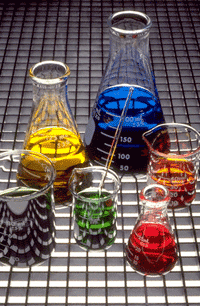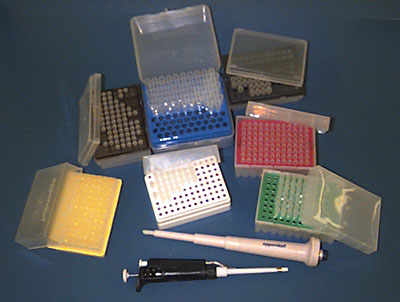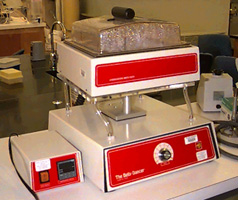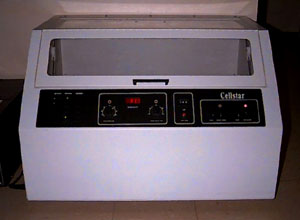Activity
1 - Student Procedure:
TESTING PHIX174 HOST RANGE

Activity
1 - Student Procedure:
TESTING PHIX174 HOST RANGE

Wet
Lab (Hands-On):
Be sure to use proper aseptic techniques throughout. This includes disinfecting
lab benches before and after use, washing hands before and after the experiment,
flaming test tubes after opening and before closing, using sterile pipets and
tubes, and cleaning up spills with disinfectant solution. Bacterial waste (including
contaminated pipets and tubes) should be discarded in a designated biohazard
container for later sterilization.
1. Start by serially diluting the concentrated Phi X 174 bacteriophage stock
solution (provided in tube A):

(Eppendorf Pipettors, Image from Bio-Link.Org, NSF 2002)
2. For each of
the bacterial strains you will test, using the sharpie pen, label the bottom
(not the interchangeable lid!) of four base agar plates with the name of the
strain and the name of your group. Mark the first plate as the (negative) control
plate. Label the other three plates as A, B, and C.
3. Take one tube of soft agar out of the 47’C water bath and wipe the
outside with a Kimwipe. Quickly add 0.2 ml of the appropriate bacterial culture
to the soft agar tube and mix gently. Pour the mixture over the base agar on
the control plate. Replace the plate lid. You may have to tilt the plate around
to evenly spread the soft agar.

(Stovall Belly Dancer Hybridization Bath, Image from Bio-Link.Org, NSF 2002)
4. Take another
soft agar tube and wipe the outside. Quickly add 0.2 ml of the same bacterial
strain, plus 0.2 ml of the tube A bacteriophage solution. Mix gently as before,
and pour the mixture over the base agar in plate A. Spread evenly.
5. Repeat step 4 for plates B and C.
6. Repeat steps 2, 3, 4 and 5 for each bacterial strain to be tested.
7. Once the soft agar on all the plates has solidified, incubate the plates
upside down in a 37’C incubator overnight.

(Cellstar Radial Shaker Incubator, Image from Bio-Link.Org, NSF 2002)
8. The next day, count the number of plaques on each plate. Numbers in excess of 300 plaques per plate should be recorded as TNTC (Too Numerous To Count). Also record plaque morphology (shape, size, clear vs. opaque, and presence vs. absence of a halo).